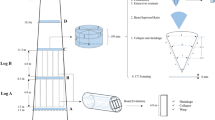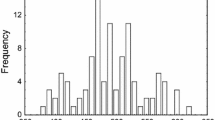Summary
Tangential shrinkage was measured on longitudinal-tangential slices of separate earlywood and latewood from one board of Eucalyptus regnans F.Muell. at various temperatures. Large amounts of collapse shrinkage were measured in the latewood slices, and lesser amounts in the earlywood slices. Collapse shrinkage in the earlywood was found only when the slices were dried at temperatures above a minimum temperature (the “collapse threshold temperature”). End-coated board sections approximately 200 mm long were rapidly dried at dry-bulb temperatures below the collapse threshold temperature for earlywood. Incipient internal checks were found in the latewood of these boards. Board sections dried at higher temperatures showed internal checks starting in both early and latewood. A non-linear drying simulation model was modified to take the heterogeneous nature of wood into account. This model predicted that internal checks would form in this wood even if it were dried sufficiently slowly to avoid surface checking.
Similar content being viewed by others
Abbreviations
- D:
-
Diffusion coefficient
- ec :
-
Creep strain
- ei :
-
Instantaneous strain
- em :
-
Mechano-sorptive strain
- en :
-
Net strain
- eu :
-
Unconfined shrinkage strain
- EW:
-
Earlywood
- FSP:
-
Fibre saturation point
- LW:
-
Latewood
- L-T:
-
Longitudinal-tangential slice
- MC:
-
Moisture content (kg water/kg dry wood)
- q:
-
Moisture concentration
- R-T:
-
Radial-tangential slice
- t:
-
Time
- y:
-
Depth in board
References
Booker, J. D. 1994: Acoustic emission related to instantaneous strain in Tasmanian ecualypt timber during seasoning. Wood Sci. Technol. 28: 249–259
Chafe, S. C.; Barnacle, J. E.; Hunter, A. J.; Ilic, J.; Northway, R. L.; Rozsa, A. N. 1992: Collapse: An Introduction. CSIRO Div. For. Prod. Melbourne Australia
Doe, P. E.; Oliver, A. R.; Booker, J. D. 1994: A non-linear strain and moisture content model of variable hardwood drying schedules. Paper presented at 4th IUFRO International Wood Drying Conference, 9–13 August 1994, Rotorua, New Zealand
Innes, T. C. 1996: Collapse free pre-drying of Eucalyptus regnans F.Muell. Holz Roh-Werkstoff 53: 403–406
Oliver, A. R. 1991: A model of the behaviour of wood as it dries (with special reference to Eucalypt materials). Research Report CM91-1, Civil and Mechanical Engineering Department, University of Tasmania
Ranta-Maunus, A. 1994: Computation of moisture transport and drying stresses by a 2-D FE programme. Paper presented at 4th IUFRO International Wood Drying Conference, 9–13 August 1994, Rotorua, New Zealand
Rohsenow, W. M.; Choi, H. Y. 1961: Heat, mass and momentum transfer. Prentice-Hall, Englewood Cliffs
Wu, Qinglin 1989: An investigation of some problems in drying of Tasmanian eucalypt timbers. MEngSci Thesis, University of Tasmania
Yang, Jun Li 1994: X-ray densitometry plots, unpublished
Author information
Authors and Affiliations
Additional information
The author is pleased to acknowledge the assistance of Emeritus Professor A. R. Oliver, Associate Professor P. E. Doe, University of Tasmania, and the Australian Furniture Research and Development Institute
Rights and permissions
About this article
Cite this article
Innes, T.C. Collapse and internal checking in the latewood of Eucalyptus regnans F.Muell. Wood Sci.Technol. 30, 373–383 (1996). https://doi.org/10.1007/BF00244434
Received:
Issue Date:
DOI: https://doi.org/10.1007/BF00244434




